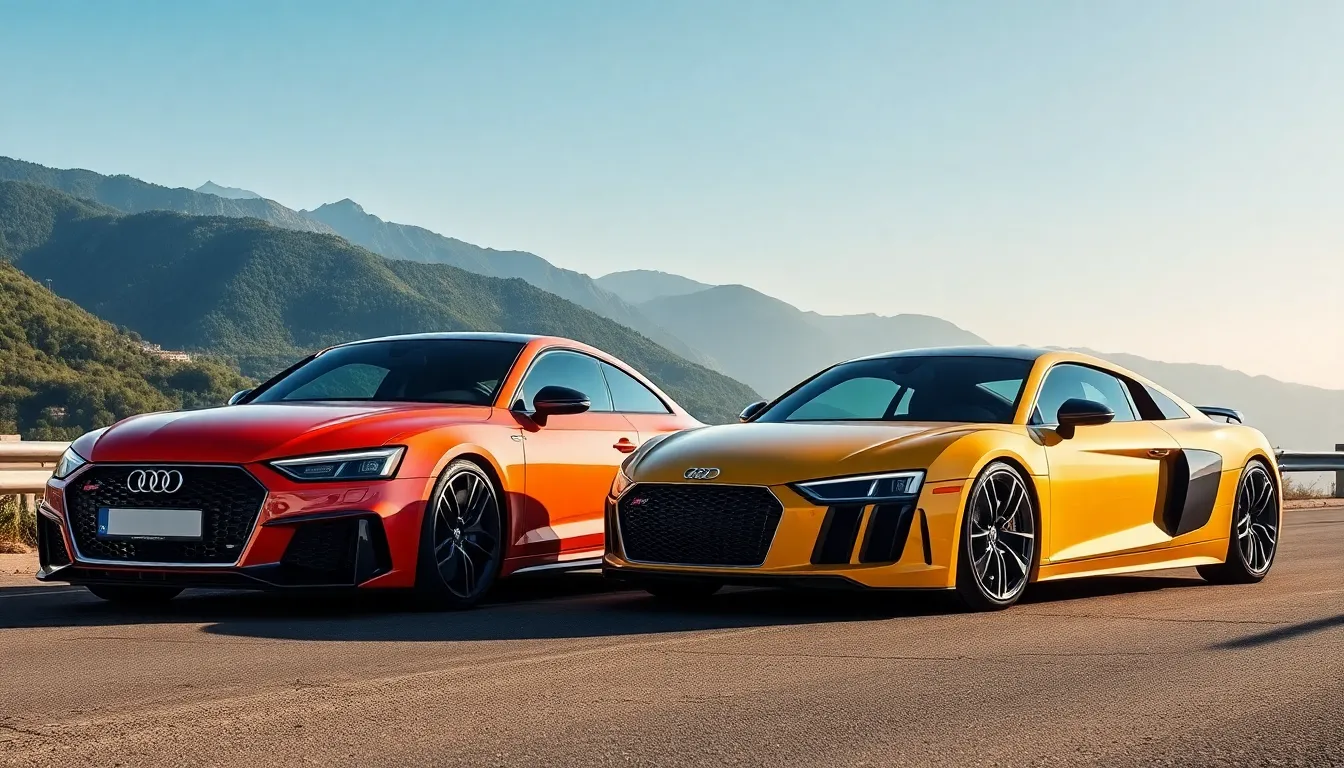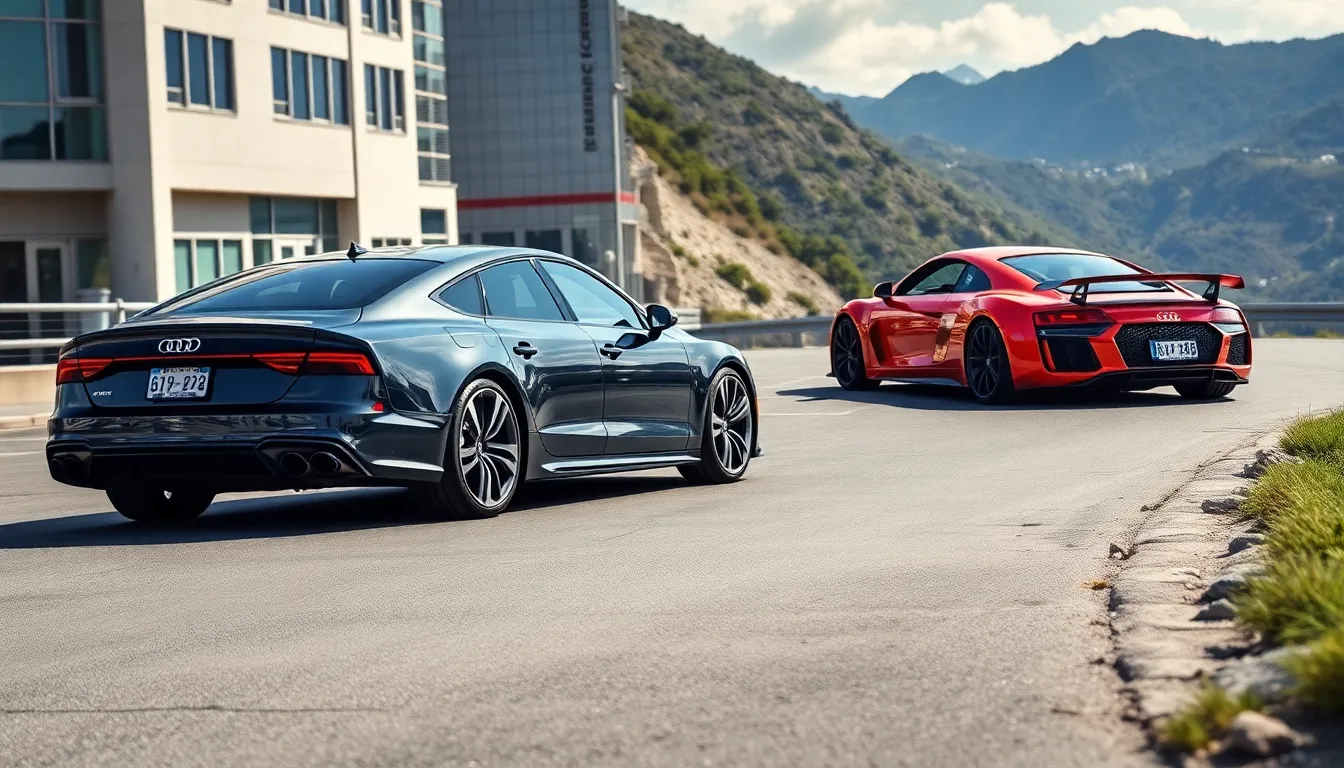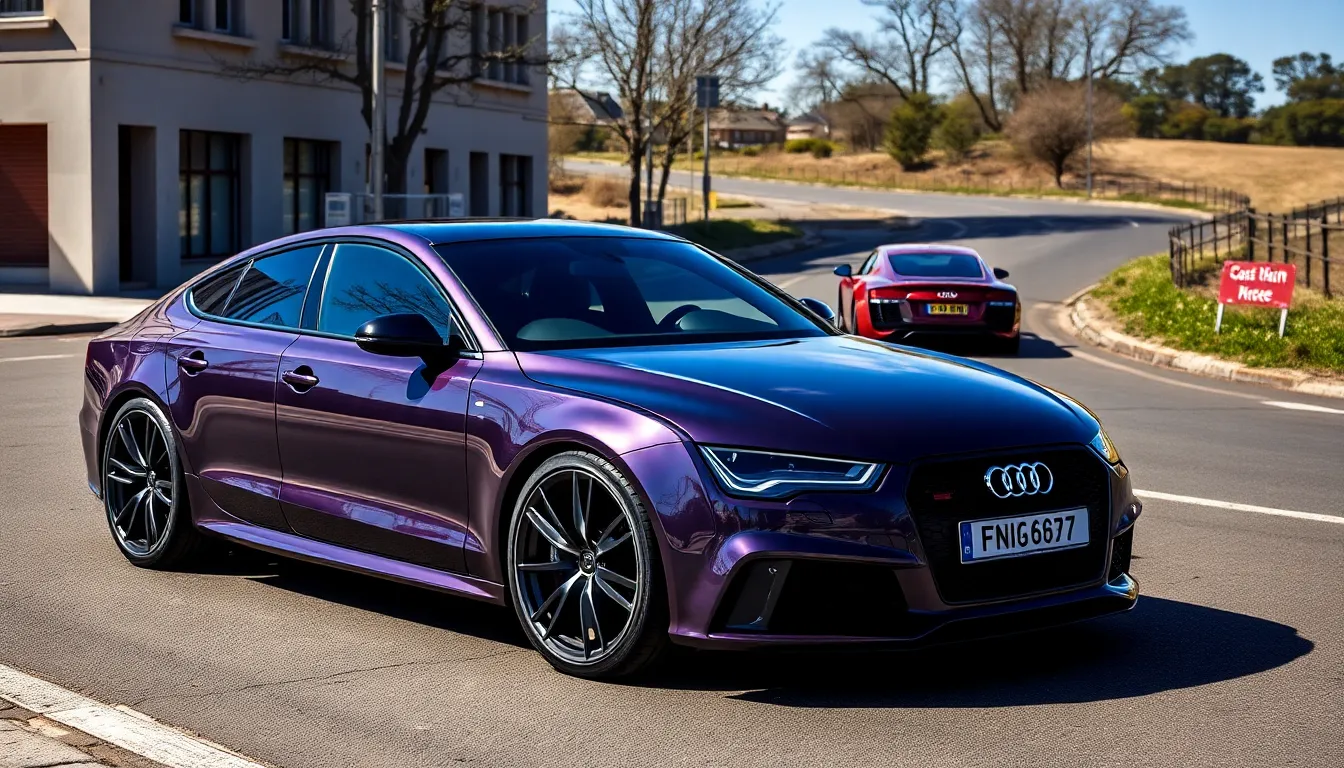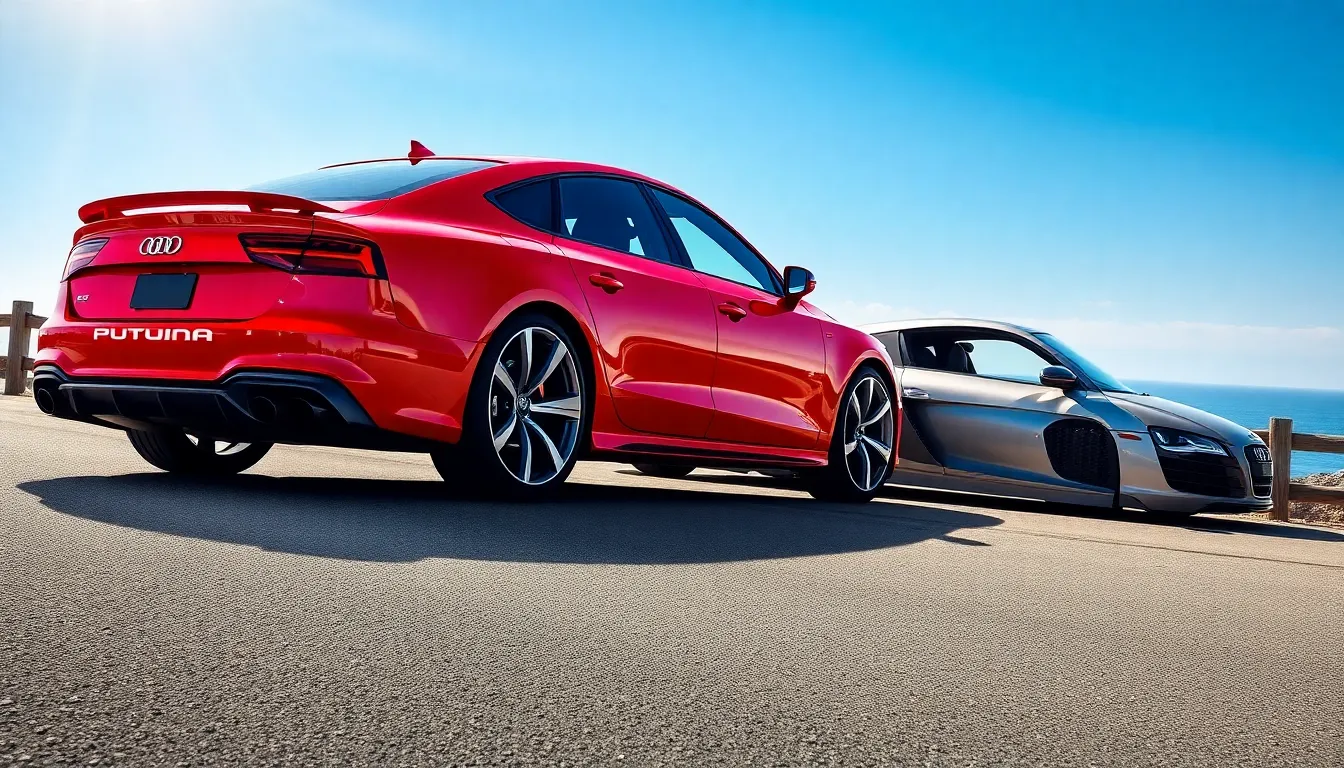When it comes to Audi’s performance crown jewels, the RS7 and R8 represent two distinctly different approaches to automotive excellence. We’re diving into a comparison that pits practical luxury against pure supercar thrills – and the choice isn’t as straightforward as you might think.
The RS7 delivers devastating performance wrapped in a sophisticated four-door package that won’t compromise your daily driving needs. Meanwhile, the R8 throws practicality out the window in favor of mid-engine supercar purity that’ll make your heart race every time you turn the key. Both cars share Audi’s DNA for precision engineering, but they target completely different driving experiences.
We’ll break down everything from performance specs and handling characteristics to real-industry usability and value proposition. Whether you’re seeking the ultimate daily driver or weekend track weapon, understanding these fundamental differences will help you make the right choice for your garage.
Design and Styling Comparison
The Audi RS7 and R8 showcase dramatically different design philosophies that reflect their unique purposes in Audi’s lineup. Each model demonstrates distinct styling approaches that immediately communicate their intended driving experiences.
Exterior Design Philosophy
The RS7 adopts an aggressive four-door coupe silhouette that balances sporty aesthetics with practical functionality. Its elongated roofline slopes dramatically toward the rear, creating a fastback profile that distinguishes it from traditional sedans. Audi’s signature Singleframe grille dominates the front fascia with a wider, more imposing presence than standard A7 models.
Muscular wheel arches house 21-inch wheels as standard, while the rear spoiler deploys automatically at speeds above 75 mph. The RS7’s design language emphasizes width through horizontal lines and flared fenders that accommodate the quattro all-wheel-drive system’s mechanical requirements.
The R8 embraces pure supercar proportions with its mid-engine architecture creating a dramatically different visual statement. Low-slung bodywork stretches just 1,240mm in height compared to the RS7’s 1,422mm, giving the R8 an unmistakably exotic presence. Sharp creases and angular surfaces replace the RS7’s flowing lines, while large side intakes behind the doors serve both functional and aesthetic purposes.
Carbon fiber components appear throughout the R8’s exterior, including the rear wing and side blades that can be customized in various finishes. The R8’s front end features a hexagonal grille flanked by sharp LED headlights that create an aggressive expression distinct from other Audi models.
Interior Layout and Features
The RS7’s cabin prioritizes luxury and technology integration within a traditional four-seat configuration. Dual touchscreens dominate the dashboard with the upper 10.1-inch display controlling infotainment functions while the lower 8.6-inch screen manages climate and vehicle settings. Premium materials include Valcona leather upholstery, carbon fiber trim, and aluminum accents throughout the spacious interior.
Rear passengers enjoy generous legroom and dedicated climate controls, making the RS7 suitable for daily family use. The cabin accommodates five passengers when equipped with the optional rear bench seat, though individual rear seats provide superior comfort and support.
The R8’s interior reflects its focused performance mission through a driver-centric layout that eliminates rear seating entirely. Carbon fiber surrounds occupy important portions of the dashboard and door panels, while the flat-bottom steering wheel positions controls for immediate access during spirited driving.
Audi’s Virtual Cockpit Plus provides a 12.3-inch digital instrument cluster that displays navigation, performance data, and vehicle information directly in the driver’s line of sight. The R8’s cabin features sport seats with extensive adjustment ranges and integrated headrests that provide optimal support during high-performance driving scenarios.
Storage space remains minimal in the R8 with only 226 liters of cargo capacity split between front and rear compartments, contrasting sharply with the RS7’s 535-liter trunk that expands to 1,390 liters with rear seats folded.
Performance and Engine Specifications

When we examine the heart of these Audi performance machines, distinct engineering philosophies emerge that define each model’s character. The RS7 delivers turbocharged power through a sophisticated V8 setup, while the R8 relies on natural aspiration with its legendary V10 engine.
RS7 Performance Metrics
The RS7 Sportback houses a 4.0-liter twin-turbo V8 engine that generates between 591 bhp and 605 bhp depending on the Performance variant. Torque output reaches an impressive 750 Nm, providing exceptional low-end power delivery that makes daily driving effortless.
Our analysis reveals the RS7’s 8-speed automatic tiptronic transmission optimizes power distribution across all driving scenarios. Acceleration from 0-60 mph takes approximately 3.2 seconds, demonstrating supercar-level performance in a practical five-seat package.
Weight distribution plays a crucial role in the RS7’s dynamics, with the vehicle tipping the scales at approximately 2,024 kg. Fuel consumption registers at 11.6 L/100km combined, offering reasonable efficiency considering the performance output.
R8 Performance Capabilities
Performance enthusiasts gravitate toward the R8’s 5.2-liter naturally aspirated V10 engine, which produces between 533 bhp in the standard V10 and 610 bhp in the V10 Plus configuration. Peak torque reaches 560 Nm, delivered with the immediate throttle response that only natural aspiration provides.
The R8’s 7-speed dual-clutch automatic transmission ensures lightning-fast gear changes that complement the engine’s high-revving nature. Sprint times from 0-60 mph drop to approximately 2.6 seconds in the V10 Plus variant, showcasing pure supercar acceleration.
Lightweight construction benefits the R8 significantly, with a curb weight of approximately 1,643 kg creating an exceptional power-to-weight ratio. Advanced features like cylinder-on-demand technology help manage fuel consumption during lighter driving conditions, though overall efficiency remains secondary to performance delivery.
Driving Experience and Handling

The RS7 and R8 deliver fundamentally different driving experiences that reflect their distinct engineering philosophies. Each model excels in its intended environment while offering unique advantages for different driving scenarios.
RS7 Daily Driving Comfort
The RS7 Sportback transforms daily commuting into an captivating yet comfortable experience. Adaptive air suspension technology adapts to road conditions automatically, providing smooth rides over various surfaces while maintaining sporty handling characteristics when needed. We observe exceptional refinement in the cabin insulation that minimizes road noise and wind disturbance during highway cruising.
Interior space accommodates five passengers comfortably with generous legroom throughout the cabin. Trunk capacity exceeds typical sports cars significantly, allowing practical cargo storage for weekend trips or daily errands. The tiptronic transmission delivers seamless gear changes in stop-and-go traffic while providing responsive shifts during spirited driving sessions.
Ride quality remains compliant even with the sport suspension settings engaged. Long distance travel becomes effortless thanks to supportive seating and advanced climate control systems that maintain optimal cabin conditions. Daily usability extends beyond comfort to include practical features like multiple driving modes that adjust throttle response, suspension stiffness, and steering weight according to road conditions.
R8 Track-Focused Dynamics
The R8’s mid-engine layout creates exceptional balance and agility that becomes immediately apparent on winding roads. Weight distribution sits at 1,643 kg compared to the RS7’s 2,024 kg, resulting in a power-to-weight ratio of 372 PS per tonne versus 299 PS per tonne for the RS7. This advantage translates directly into sharper turn-in responses and more precise cornering capabilities.
Track performance benefits from advanced aerodynamics and stiffer suspension tuning that prioritizes handling precision over ride comfort. The R8 V10 Plus accelerates from 0-60 mph in 2.6 seconds, outpacing the RS7’s 3.2-second time by a important margin. Higher speed performance maintains this advantage through superior aerodynamic efficiency and reduced weight.
Ceramic brake systems provide exceptional stopping power with consistent performance during repeated high-speed braking scenarios. Driver engagement reaches maximum levels through direct steering feedback and immediate throttle response that connects the driver intimately with road conditions. Cornering speeds exceed the RS7’s capabilities due to lower center of gravity and optimized chassis dynamics designed specifically for track environments.
Technology and Features

Technology integration distinguishes these two Audi performance vehicles through distinct approaches that reflect their primary purposes. Each model incorporates advanced systems customized to its exact driving mission.
Infotainment Systems
Both vehicles feature Audi’s MMI infotainment platform, yet their implementations serve different priorities. The RS7 delivers a comprehensive technology experience with a large touchscreen interface, virtual cockpit display, and extensive connectivity options that enhance the luxury driving experience. Advanced navigation systems, smartphone integration, and premium audio configurations support long-distance comfort and entertainment needs.
The R8 adopts a sport-focused approach to infotainment that prioritizes driving engagement over digital complexity. Its digital displays provide essential driving information while maintaining a minimalistic interface that reduces distractions during performance driving. Navigation systems and basic connectivity features remain available, though the overall system emphasizes simplicity and driver concentration.
Screen sizes and interface layouts differ significantly between models, with the RS7 offering larger displays suited for daily use and the R8 featuring smaller, more focused screens that complement its cockpit design. Audio systems in both vehicles maintain high quality, though the RS7’s setup typically includes more speakers and advanced sound processing features.
Driver Assistance Technologies
The RS7 incorporates an extensive suite of semi-autonomous driving features designed for comfort and safety in various driving conditions. Adaptive cruise control automatically adjusts speed based on traffic flow, while lane keeping assist helps maintain proper road positioning during highway travel. Traffic jam assist reduces driver fatigue in stop-and-go situations, and multiple safety sensors monitor surrounding vehicles and obstacles.
Emergency braking systems, blind spot monitoring, and parking assistance features enhance the RS7’s appeal as a daily driver. These technologies work together to create a more relaxed driving experience during commutes and long trips.
The R8 takes a deliberately minimalist approach to driver assistance, emphasizing direct driver control over automated systems. Basic safety features include standard airbag systems and stability control, but the vehicle lacks many semi-autonomous technologies found in the RS7. This design philosophy maintains the pure driving connection that supercar enthusiasts prefer.
Traction control and electronic stability programs in the R8 focus on performance enhancement rather than comfort convenience. The vehicle’s assistance systems activate primarily during extreme driving situations, allowing skilled drivers to maintain maximum control during spirited driving sessions.
Pricing and Value Proposition

Cost differences between these Audi models reach substantial levels that affect purchasing decisions significantly. We observe the RS7’s MSRP typically ranges from $128,600 to $257,400 depending on model year and trim specifications. Conversely, the R8 commands considerably higher pricing from approximately $158,600 up to $416,377 for premium variants.
Current model year pricing reveals even starker contrasts. The 2025 Audi RS7 Sportback carries an MSRP around $246,969 to $257,400. Meanwhile, 2023 Audi R8 models start at approximately $294,877 for the base coupe and escalate to $416,377 for the Spyder high-performance version.
Performance value calculations favor the RS7 in several key metrics. This four-door delivers more power than the 2017 R8 V10 while achieving better fuel efficiency. Raw acceleration numbers show the R8 edging out the RS7 by roughly 0.1 seconds in 0-60 mph times. Power-to-weight ratios also lean toward the R8’s advantage.
| Aspect | Audi RS7 | Audi R8 |
|---|---|---|
| MSRP Range | $128,600 – $257,400 | $158,600 – $416,377 |
| Cargo Capacity | 535 liters | Limited storage |
| Seating | 4-door with rear seats | 2-seat configuration |
| Warranty Coverage | 5 years | 3 years |
| Primary Use Case | Daily driver with sport performance | Pure sports car and track use |
Practical considerations dramatically shift the value equation. The RS7 provides ample cargo space measuring 535 liters, accommodating real-industry storage needs. Standard features include wireless phone charging, adaptive cruise control, climate control, reversing sensors, and cameras. Extended warranty coverage spans approximately 5 years compared to the R8’s 3-year protection.
Daily usability represents the RS7’s strongest advantage over its supercar sibling. Four doors and rear seating accommodate passengers comfortably for various driving scenarios. Track-focused buyers gravitate toward the R8’s two-seat configuration and limited cargo space. Pure sports car enthusiasts prioritize driving thrills over everyday practicality.
Value propositions diverge based on intended usage patterns. Buyers seeking performance with practicality find compelling arguments in the RS7’s combination of speed, efficiency, utility, and lower price point. Flagship supercar buyers accept higher costs for unmatched styling and track-capable performance. The R8 attracts purchasers who prioritize sporty aesthetics and driving engagement above practical considerations.
Practicality and Everyday Use

The practicality gap between the RS7 and R8 becomes immediately apparent when we examine their real-industry usability. Daily driving scenarios reveal fundamental differences in design philosophy that impact everything from passenger comfort to fuel costs.
Cargo Space and Seating
Passenger accommodation demonstrates the RS7’s clear advantage in practical applications. The RS7 provides seating for five occupants with generous legroom across all positions, making it suitable for family trips or business travel with colleagues. Front passengers enjoy premium leather-appointed seats with extensive adjustment ranges, while rear passengers access comfortable seating even though the coupe-like roofline.
Storage capacity further emphasizes the RS7’s versatility advantage. The sportback design incorporates a substantial cargo area that accommodates multiple suitcases, golf bags, or weekly grocery runs without compromise. Loading and unloading remains convenient through the large hatchback opening, eliminating the awkward maneuvering required with traditional trunk designs.
R8 seating restricts occupancy to two passengers in a driver-focused cockpit environment. The interior prioritizes performance ergonomics over passenger comfort, with sport seats designed for lateral support during aggressive cornering. Storage space becomes severely limited, with minimal compartments for personal items and virtually no cargo capacity for extended trips.
Fuel Economy Considerations
Fuel efficiency calculations reveal the RS7’s practical advantage for daily commuting and long-distance travel. The twin-turbo V8 configuration delivers better fuel economy compared to the R8’s naturally aspirated V10, reducing operating costs significantly over time. Real-industry testing shows the RS7 achieving reasonable efficiency ratings even though its performance capabilities.
Driving range extends considerably further in the RS7 configuration. A full tank provides substantially more miles between fuel stops compared to the R8, which typically achieves 876 to 1112 km range from its 73L fuel capacity. This difference becomes particularly important during highway cruising or road trip scenarios where fuel stations may be scarce.
Operating costs favor the RS7 across multiple expense categories. Lower fuel consumption translates to reduced annual fuel budgets, while the practical design accommodates various driving scenarios without requiring additional vehicle ownership. The R8’s fuel-intensive nature makes it more suitable as a weekend sports car rather than a primary transportation solution.
Which Audi Should You Choose?

Your decision between the RS7 and R8 eventually depends on how you prioritize performance versus practicality in your automotive lifestyle. Both vehicles deliver exceptional German engineering excellence but serve distinctly different purposes in the luxury performance segment.
Choose the Audi R8 if you value:
- Pure driving thrills with track-focused dynamics and superior handling precision
- Exotic supercar aesthetics that command attention wherever you drive
- Lightweight construction at 3,622 lbs for optimal power-to-weight ratio performance
- Acceleration superiority with 0-60 mph times of approximately 2.6 seconds
- Mid-engine layout technology shared with Audi’s GT3 race car platform
- Weekend sports car experience with minimal storage concerns
Choose the Audi RS7 if you prioritize:
- Daily driving versatility with five-passenger seating capacity and generous cargo space
- Superior value proposition at €138,000 compared to the R8’s €203,000 price point
- Higher torque output of 553 lb-ft for strong acceleration across all driving scenarios
- Practical luxury with adaptive air suspension balancing comfort and sportiness
- Advanced MMI infotainment systems and comprehensive driver assistance features
- Better fuel efficiency for commuting and long-distance travel requirements
Budget considerations significantly impact this comparison since the R8 commands approximately €65,000 more than the RS7. Performance per dollar calculations favor the RS7 when factoring raw horsepower delivery and everyday usability metrics.
Lifestyle Compatibility Assessment:
| Usage Scenario | RS7 Advantage | R8 Advantage |
|---|---|---|
| Daily commuting | Comfort suspension, fuel efficiency | Pure driving engagement |
| Family transportation | Five seats, cargo capacity | Not applicable |
| Track days | All-wheel drive stability | Lightweight, mid-engine balance |
| Weekend trips | Practical storage, range | Exotic experience |
| Business travel | Professional appearance | Eye-catching presence |
Your driving frequency also influences this decision significantly. The RS7 excels as a primary vehicle handling diverse transportation needs from grocery runs to business meetings. The R8 functions optimally as a secondary vehicle dedicated to enthusiast driving experiences and special occasions.
Consider maintenance costs and ownership experience when evaluating long-term value. The RS7 offers five-year warranty coverage compared to the R8’s three-year protection period. Insurance premiums typically run higher for the R8 due to its supercar classification and replacement costs.
Geographic location affects usability differently for each model. Urban environments favor the RS7’s practicality and understated luxury sedan appearance. Rural areas with winding roads showcase the R8’s handling superiority and exotic appeal.
Both vehicles represent Audi’s engineering excellence but cater to fundamentally different automotive enthusiast profiles. The RS7 delivers supercar performance wrapped in executive sedan practicality while the R8 provides pure sports car thrills with minimal compromise for everyday convenience.
Conclusion
Both the Audi RS7 and R8 represent the pinnacle of German engineering excellence but serve distinctly different purposes in our automotive industry. We’ve seen how each vehicle excels in its respective domain – the RS7 as a versatile performance sedan that doesn’t compromise daily usability and the R8 as a pure-bred supercar that prioritizes driving thrills above all else.
Your choice eventually depends on how you plan to integrate these machines into your lifestyle. If you’re seeking a single vehicle that can handle everything from morning commutes to weekend adventures the RS7 delivers unmatched versatility. But if you’re looking for that special occasion vehicle that transforms every drive into an unforgettable experience the R8 stands ready to deliver.
We believe both models showcase Audi’s commitment to performance innovation and each represents a worthy investment for the right enthusiast.
Frequently Asked Questions
What are the main differences between the Audi RS7 and R8?
The RS7 is a practical four-door luxury performance car designed for daily driving, while the R8 is a dedicated two-seat supercar focused on pure performance. The RS7 offers more passenger space, cargo capacity, and everyday usability, whereas the R8 delivers track-focused dynamics with a mid-engine layout and superior power-to-weight ratio.
Which car is faster, the RS7 or R8?
The R8 is faster, achieving 0-60 mph in approximately 2.6 seconds (V10 Plus variant) compared to the RS7’s 3.2 seconds. The R8’s lighter weight (1,643 kg vs 2,024 kg) and mid-engine design provide superior acceleration and handling performance, making it the more track-capable vehicle.
How much do the RS7 and R8 cost?
The 2025 RS7 Sportback ranges from $246,969 to $257,400, while the 2023 R8 models start around $294,877. Generally, the RS7’s MSRP ranges from $128,600 to $257,400, while the R8 commands higher prices from approximately $158,600 to $416,377, depending on the specific variant and options.
Which car offers better fuel economy?
The RS7 offers better fuel economy than the R8, making it more suitable for daily commuting and long-distance travel. The RS7’s twin-turbo V8 engine is more efficient than the R8’s naturally aspirated V10, resulting in lower operating costs and longer driving range for everyday use.
Can the RS7 accommodate passengers and cargo?
Yes, the RS7 comfortably seats five passengers with generous legroom and offers substantial cargo space, making it ideal for family trips or business travel. In contrast, the R8 is limited to two passengers and has minimal storage space, prioritizing performance ergonomics over practical accommodation.
Which car is better for daily driving?
The RS7 is significantly better for daily driving, featuring adaptive air suspension for comfort, spacious interior, practical trunk capacity, and advanced driver assistance technologies. The R8’s track-focused suspension and minimal storage make it more suitable as a weekend sports car rather than a daily driver.
What engines do the RS7 and R8 use?
The RS7 features a 4.0-liter twin-turbo V8 engine producing 591-605 bhp with 750 Nm of torque, paired with an 8-speed automatic transmission. The R8 uses a 5.2-liter naturally aspirated V10 engine generating 533-610 bhp with 560 Nm of torque, connected to a 7-speed dual-clutch transmission.
Which car offers better value for money?
The RS7 offers better overall value, delivering more power than some R8 variants while providing superior fuel efficiency, practical advantages, longer warranty coverage (five years vs three years), and everyday usability. The R8 commands premium pricing for its supercar status and track-focused performance capabilities.







